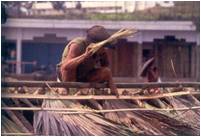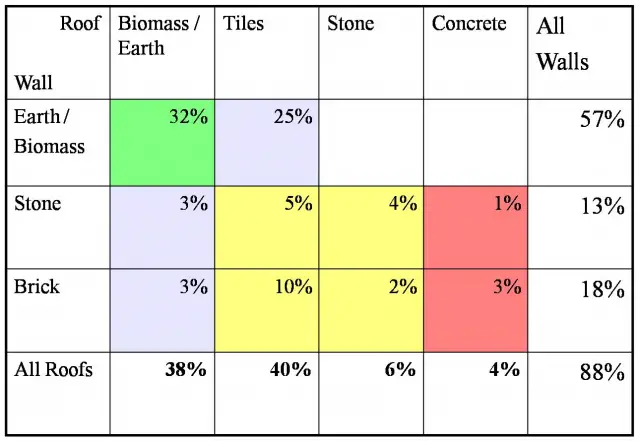
The Built Environment is more than just Four Walls & a Roof
- It is (among many things)
- Shelter
- Security
- Locus of family and community life
- Cultural continuity
- Expression of identity and solidarity
- Home: sense of place and time
- Knowledge generation, cultural transmission and conservation around the built environment must be viewed in this holistic perspective.

- The commoditization of the built environment leads to its:
- De-linking from the community and the sacred
- Institutionalization of the ‘tragedy of the commons’
- The rent vs. ownership polarization has been rationalized by the need to reduce transaction costs – the real price is much higher
- Even the framers of the Constitution fell into this ‘trap’
- Need for a re-examination of the plurality of property and its relations: private …common access …commons
- This plurality (a little like bio-diversity) is the cornerstone of ‘indigenous’ and sometimes ‘traditional’ (read caste India) cultural relationships and knowledge of the built environment
- ‘Rebuilding the built environment is often equivalent to re-generating local community and culture’
Real Estate as a Metaphor for ‘property rights’
- Vernacular housing in India is based on ‘human-scale’, locally available, low energy and transportation intensive technology that is largely within the locus of control of the user-producer
- This makes up less than 25-50% of the value of ‘real estate’ in metropolitan and urban areas
- Much of this ‘value’ is speculative, unsustainable and hugely exploitative of the people employed in producing it
- As the value of real estate, embodied energy and transportation increases so does the potential ‘income’ from exclusive IPRs from industrial materials
- Technology, certified skills, standards and specifications and ‘law’ are barriers to entry that ensure ‘super-normal’ profit to professionals and the organized sector
- Vernacular traditions and culture have been the first victims of these processes.
Why Culture is central to the built environment in India
- India will continue to be predominantly rural for a long time (at least two decades)
- Rate of urban growth has declined for the 2nd decade in a row
- Urban informal building retains many of the attributes of the ‘remembered village’
- Artisanal (and self) production of buildings will continue to be dominant mode of production
- The transmission of knowledge will continue to follow a traditional non-formal on-the-job mode
- This is in spite of the best/worst efforts of the entire techno-scientific-legal establishment
- Changes in economic structure, relative scarcity of materials and skills and changing ‘aspirations’ will profoundly effect this.
Key Building Materials In India
- Natural
- Biomass (Thatch, Timber, Bamboo etc.)& Earth
- Stone
- Fired Clay-based
- Brick
- Tile
- Industrial
- Steel
- Cement
- Other industrial products (sheets, blocks etc.)
The Indian Building Transformation Matrix (1991)

Housing: Modes of Production in India (NSS 98 etc.)
- Community Self-help (~ 5%)
- Self-built (~20%)
- Self + Artisan (~40%)
- Artisan (~30%)
- Contractor (~5%)
- Unit cost range two orders of magnitude: Rs. 5 – 400/sqm
- Gross on-site employment ~ 3.5 million
- Will change with change in technology & locus of control
Processes in the Built Environment: Life-cycle Analysis
- Building Materials production/extraction
- Building materials production
- Building construction processes
- Building maintenance
- Recycling of materials
- Services provision
- Vernacular tradition is central to each of these processes, but ‘modern’ industrial technology has the upper hand in terms of durability, productivity, speed of production, institutionalized knowledge generation and ideological momentum.
Is the Assam Pattern House Indigenous, Traditional or Modern?
- Exotic origin: Shillong earthquake
- Indigenous adaptation
- Traditional appropriation (incl. by the PWD)
- Modern
- Modular
- Composite structure
- Disaster resistant
- Post-Modern
- Local materials, employment and control
- Bamboo-ply sheet replaces galvanized iron?
Indigenous or Traditional ‘Treatment’ of Timber
- Indigenous selection, seasoning and treatment of timber – advanced ‘scientific’ and cultural practice
- Traditional treatment: ‘let it rot’
- First, hugely difficult to replicate
- Second, a stupid and wasteful practice
- This is a classic management challenge
- Traditional users/artisans largely in control over resource/material
- Technical knowledge lies in ‘ivory’ towers
- Never the twain shall meet
- No amount of regulation or legal protection (alone) can address these problems
Why are country tiles being used for Hotel roofs?
- Death of the ‘village potter’ in central, western and eastern India
- Huge life-cycle costs of timber and bamboo
- Annual maintenance and loss of tiles
- Fewer old houses to recycle tiles from
- More monkeys !
- More ‘eco-tourism’ resorts
Is the ‘Mangalore’ Tile roof Traditional or Industrial?
- Exotic: Basel Mission
- Most important roof cladding in Western, part of Southern India
- Industrial quality
- Cost-effective, timber saving
- Recyclable
- Design challenges
- Wind-lug
- Fuel efficiency
How do we promote, protect or conserve the ‘Mangalore’ Tile?
- Focus on:
- Incentives for fuel efficiency
- Changing tile design
- Improving roof substructure (less wood, greater life span)
- Expanding its use to additional areas
- Using the same production facilities for other products
- Enhance the ‘perceived aesthetic and status of the material
Threats to the Traditional Culture of the Built Environment – I
- Largely ‘internal’ to India because of the nature of the built environment: massive, usually energy intensive, costly to transport, coded into culture
- Resource extraction
- Government programmes
- Lack of ability to access locally-controlled technical innovation
- Deskilling
- Yawning gap between ‘scientific’ and cultural transmission systems
- ‘External’ threats focused and radiate from Urban centres driven by aspirations, industrial growth and ‘contractor’ culture.
Threats to the Traditional Culture of the Built Environment – II
- But ‘sector endogenous’ threats loom large because of the
- Declining ability of skilled building artisans to survive
- Fundamental contradiction of artisanal innovation
- Most of the Indian legal instruments (except possibly bio-diversity) have little connection or impact on the ‘real’ dynamics of this sector.
Knowledge building priorities
- Where the bulk of the people live ..?
- Where the bulk of the employment is … ?
- Where the bulk of the monetary investment lies..?
- Where the bulk of the ‘super-normal’ profit can be earned ?
Potential Public Policy Interventions (I)
- Rethinking the policy framework for this sector: construction still has the highest employment elasticity
- Public good vs. private profit: a case for regulation
- Changing by doing (rather than by talking)
- Improvement: ‘scientific’ development of indigenous buildings
- Testing and confidence building
- Training: linking contractor-artisan-‘user’
- Enterprise development
- Mainstreaming into ‘contracting’ practice
- Promotion:
- State-sponsored building using upgraded traditional techniques
- SM(Building)Es
- Harmonise policy objectives and instruments
- Mobilise from below to subvert entrenched interests
- Accredit and ‘regulate’ artisans and contractors around improved skills and practices
- Revise the techno-legal regime around the built environment
- Build high quality technical teams linked to institutions of ‘scientific’ excellence
Visioning Future ‘Sustainable’ Cities & Settlements
- Lack of clear and shared ‘vision(s)’ of the built environment lies at the heart of this dilemma
- Breaking the ‘Built Env = Building Houses = Real Estate’ linkage is central
- Stepping beyond the Institutionalised impoverishment of 5,000 years of built culture
- Moving towards:
- Biological rather than Mechanical metaphors
- Closed ‘through-put’ chains and Factor 5 – 10 multipliers
- Convergence of conservation, equity and efficiency concerns

Leave a Reply
You must be logged in to post a comment.